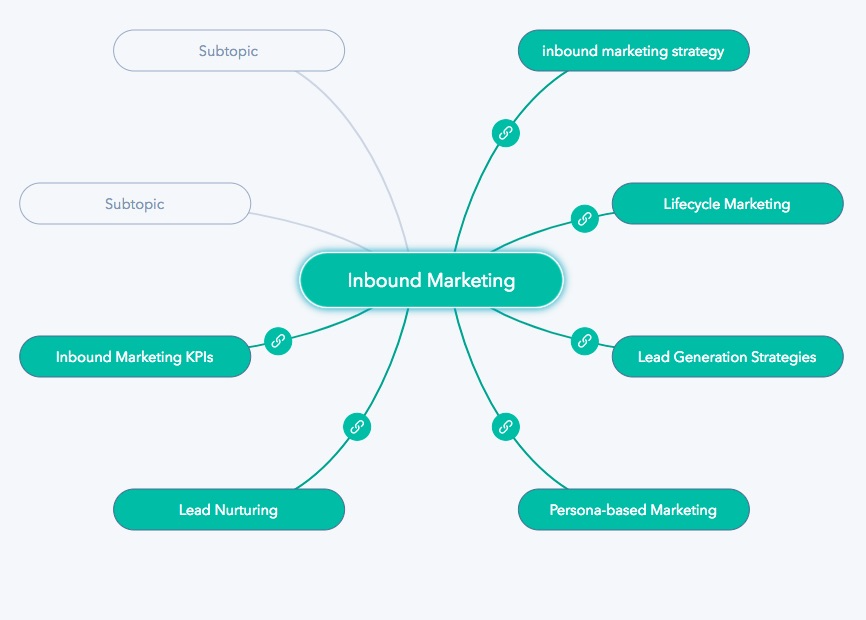 For years now, most content marketers pumped out 500-word blogs to fuel the inbound marketing campaigns of businesses around the world. It’s simply what worked to climb search engine rankings and drive visitors to websites. It was our solution to how to do search engine optimization for marketing.
For years now, most content marketers pumped out 500-word blogs to fuel the inbound marketing campaigns of businesses around the world. It’s simply what worked to climb search engine rankings and drive visitors to websites. It was our solution to how to do search engine optimization for marketing.
Then SEO evolved. Again.
In 2018, Google and other search giants switched up the algorithm to make search smarter and more intuitive. Now, instead of using the keyword equivalent of a sniper rifle like blogs, content marketers need to start using value-powered keyword grenades, also known as pillar pages.
Pillar Pages 101
Pillar Pages are the newest tool content marketers have to kick serious SEO ass within these new search algorithms. Essentially, pillars are just really long, strategic web pages (more than 5000 words) that live in the top navigation of your website and act as an ultimate resource for your prospective customers.

Think of a whole informative section of your website on one single page, Most come in the style of an ebook but there’s plenty of room for creativity. The format is pretty irrelevant as long as you’re carpet bombing one topic with thousands of your own words. Common types of pillar pages include essential guides, 101-style explanations and awesomely done ebook-style pages.
Typically, marketers start a pillar with one core topic, then research related subtopics to create their outline. Once the pillar page is completed and is setup to convert visitors into leads (or leads into customers), marketers research the topic even further to write 6-8 supporting blogs or pieces of content, called subpillars, that promote and drive traffic to the pillar page.
When it’s done right, using the best practices we’ve included below, these pages become SEO heavy-hitters, FAST. But since this content is so much more time-intensive than a 500-word blog post, it’s important to understand why they work and the principles behind the SEO magic.
Why it Works: Topic Clusters
As search queries become more conversational and natural, so does the way searches work. People aren’t really fumbling with search engines anymore, typing in a few keywords that sound like the way they assume search engines (and robots) think.
.png?width=600&name=image%20(1).png)
Instead, we’re more likely to ask Siri or Alexa to search for something using full sentences with natural, conversational language. In fact, most of today’s searches are more than 4 words long.
Without anyone telling us to, we’ve all started using search engines smarter, leveraging longer queries to get better results and weed through more of the noise online. After all, there’s an incredible amount of content on the web and quality is a far bigger concern than quantity.
The most recent changes to search engine algorithms have search engines thinking and delivering results more like people too. Search queries no longer need to be literal strings of keywords. In fact, you don’t even need the exact keyword for Google to figure out what you mean and incorporate or swap related words.
Search engines are now focused on topic clusters or hubs of related, relevant information that tackle all different angles of one subject using one large piece of content and supporting content pieces that link to it. So as marketers, we have to cast a wider net by covering one broad topic and all of the related questions our buyer personas ask about it by combining as many long-tail conversational keywords as possible.
In the past, marketers have focused on creating single web pages and blogs for single long-tail keywords. That’s just not going to work anymore. Google isn’t hunting for just a strong blip on the keyword radar like it used to do. It’s searching for the epicenter of information related to what you’re looking for.
Writing Your Pillar Page
Begin by choosing a broad topic you want to rank for. Then, start researching the questions being asked in each stage of the buyer’s journey for your topic and relevant buyer personas. Instead of diving deep into your core subject like you’re used to doing, provide as broad of an overview as possible.
Essentially, your pillar page will cover the broad strokes of a core topic at the center of your topic cluster. Create subtopic layers around it with helpful, related blogs, guest posts and other content that dives deeper into subtopics as it supports your pillar in search queries with hyperlinks and relevant information.
Tools like the Core Topic Validation in Hubspot’s content strategy tool can help you choose the most effective topics, before you start writing, by calculating domain authority, monthly search volume and topic relevance. The free Keywords Everywhere plugin tracks monthly search volume for the keywords you’re interested in, while majestic.com can show you the amount of inbound links in a piece of content you’re competing against in Google rankings.
Search topics you’re interested in using in Google and really explore what’s ranking high. How long is the content? How comprehensive it? What subtopics does it cover? All of those questions will help define the strategy of your pillar and the benchmarks you should shoot for.
Once you’ve chosen a topic you’re confident you can rank for, try to answer every question a lead might have. Use both the pillar page content and supporting blog posts to cover the main points.
Then, as you’re mapping out the topics for your pillar and supporting content, explore existing content that you can repurpose or combine so that you’re writing less from scratch and can just focus on filling in the gaps.
Once you’ve gotten a solid strategy planned out for both your pillar and subpillar content pieces, the best practices below can help to guide your writing:
Pillar Page Best Practices
- Write at least 5000 words (maybe more, depending on topic and competition)
- Include good graphics, bulleted lists, anchor links and other features of quality, long form content
- Keep your pillar pages on the top level of website for the best organic traffic reach
- Use websites like answerthepublic.com to shape your outline and 6-8 topics for supporting content or subpillars
- Include the core topic in title, page url and h1 tag
- Set up your pillar page to convert without locking the actual page content behind a form
- Include lots of inbound links by promoting your pillar on other websites with supporting content and guest posts
- Add to your pillar constantly, as information evolves, to keep it fresh and relevant to search engines
Ready to Write Powerful Pillars?
Instead of being intimidated by this new content marketing strategy, get in on the ground floor and start experimenting. With some basic SEO knowledge, a well-researched topic cluster and at least 5000 well-written words, your business can start reaping serious SEO benefits from these newest search engine algorithm changes.





